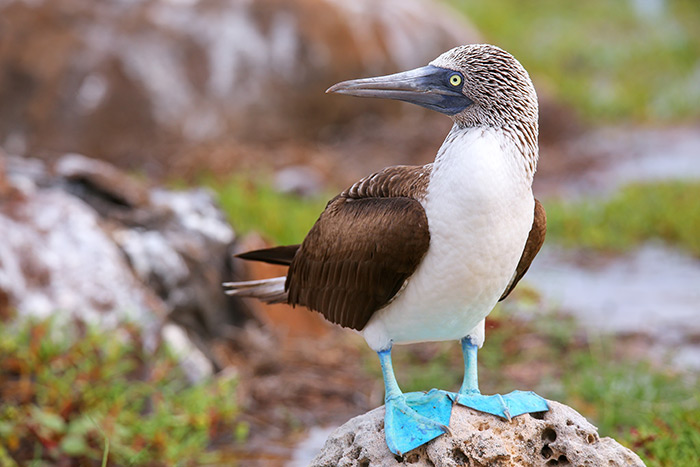Courting Rituals: Blue-Footed Booby and Giant Tortoise on the Galapagos

On the Galapagos Islands, there are creatures so tame you can walk right up to them, even pet them. The reason is that those creatures have never seen predators. As a result, they have never developed fear.
Scientists often go to the Galapagos to study the creatures. It’s so easy. Two recent studies, involved giant 800-pound tortoises. In one study reported in The New York Times, scientists were looking to find out why their numbers—the decline of which could lead to extinction—were back on the upswing. There were baby tortoises everywhere. What had happened?
The scientists found the upswing was almost entirely the result of one very frisky male. While other males showed only passing interest in females, this one guy was all over the place, mating with females. The scientists had never seen anything like it. And they had no explanation for it.
Two weeks later, another article appeared about giant tortoises, in National Geographic. There was nothing in the second that referred to the first. It might have been about a whole other species of tortoise. The article was about the day a giant male tortoise chased the writer right off an island in the Seychelles.
I will paraphrase the account:
This big male had climbed onto the back of a female. I sat still in the grass nearby, but he sensed me and then climbed down, and very slowly turned toward me. Then he came after me. He was apparently very angry about having been interrupted. He did not move very fast, and so I was able to back away, but even when I did that, he just kept right on coming. This was scary.
I backed up farther, and then turned around and walked away but there he was, slowly but surely, still after me. It was clear to me he wanted to chase me off the island entirely. I walked, with him following me in slow motion, through the tall grass, then across the runway and then, only when I broke into a long brisk sprint to get far, far away, did he turn away and head back inland. My colleagues were amazed.
The following week there was this big feature in The New York Times Magazine about another creature in the Galapagos. It’s called a blue-footed booby, and on that Sunday a picture of one graced the cover of the magazine, looking curiously out at the reader. Boobies are birds with piercing eyes, bluish-gray beaks and oversized neon blue webbed feet.
There was no indication of whether this was a male or a female. They do look the same, but the female is bigger than the male. They also couple off—and the male spends as much time raising the youngsters as the female. The one not at home is off diving for fish. He (or she) circles around just offshore, and when he sees a fish, he dive bombs it from 30 feet up, hitting the water hard at 60 miles an hour. His forehead hits first. Boobies have developed bony foreheads.
The most interesting thing about them is their mating rituals which, unlike with the tortoises—or that one tortoise—you are free to watch up close. A male approaches a female he fancies. He just walks over to her and squawks hello. He raises a leg and shows her how blue his foot is. He raises it higher so she can see the underside. She peers at it. After a few moments—the male is standing on one foot—he puts his raised foot down, and the female shows him one of her feet and how blue that is.
The male will then pick up a stone in his beak and try to place it in her beak. She might take it. If she does, he gets a stick and gives it to her. Then it’s up to her. If his feet are blue enough, they walk off proudly arm in arm, so to speak. If not, she will wave goodbye with one of her blue feet and then walk off.
Scientists are all over this blue foot business. They have found that the blue color relates to diet. If the booby doesn’t eat right, the blue fades. If he eats right, it’s neon. That’s all they’ve been able to figure out so far.









